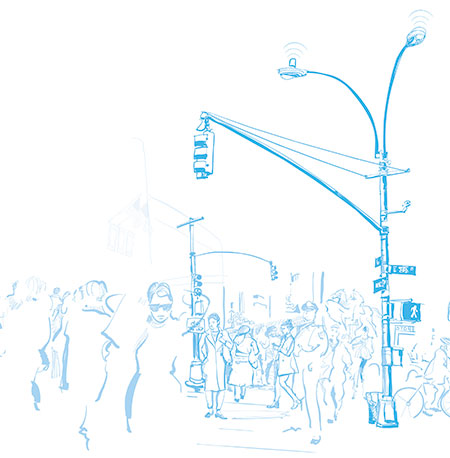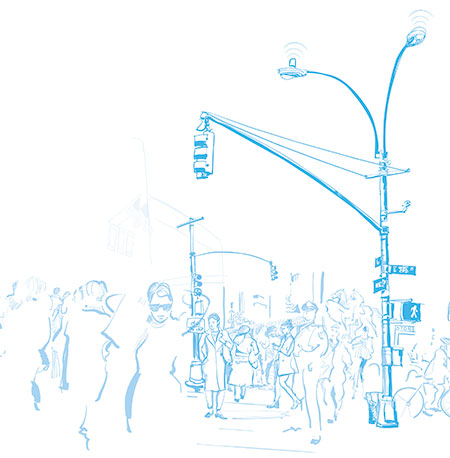It’s ‘smart cities,’ as sensor-equipped streetlights offer the proverbial mother lode of data
 By Paul Tarricone
By Paul Tarricone
There was a time when planters hanging from light poles or signage affixed to brackets to promote next weekend’s farmer’s market constituted innovation in street lighting. Today, in the age of connectivity, streetlights have gotten much smarter. As cities hope to leverage the power of big data to better manage resources, streetlights outfitted with sensors are being used by municipalities to manage traffic flow, deliver audio messages and even detect gun shots.
Three case studies, one from each coast of the U.S. plus another from the Land Down Under, show what smart cities are up to.
San Diego
In 2017, San Diego announced a $30 million initiative (in partnership with Current powered by GE) to deploy what they call the “world’s largest smart city IoT sensor platform.” The far-ranging program includes installation of 4,200 intelligent sensor nodes and 14,000 new LED fixtures (Evolve from GE) to help optimize traffic and parking, as well as enhance public safety, environmental awareness and overall livability for San Diego residents. The luminaires are forecasted to save the city $3.6 million annually in energy and maintenance costs. Each fixture also comes equipped with an advanced controls system called Light- Grid which allows city managers to dim, brighten and check maintenance on the lights remotely through a single dashboard.
In late 2018, San Diego debuted the first “smart city apps” for the project. The apps provide data visualization software for parking and traffic safety improvements, and support police and first responders. It’s all hands on deck in San Diego, as the Office of Economic Development, San Diego Police Department and the Traffic Engineering and Operations Division are already working with the data to improve traffic flow and pedestrian safety.
Moreover, San Diego will use its streetlights as a crime-fighting weapon via ShotSpotter technology, which can detect the location of gunshots in realtime and provide the location to law enforcement.
Syracuse, NY
The initiative is named “Syracuse Surge”—an ironic moniker considering that energy use will go down thanks to a network of smart streetlights. As for the “surge,” the city is banking on a $200 million investment in technology to make Syracuse New York State’s flagship smart city and a model for other municipalities hoping to leverage data to spur both economic development and better day-to-day operations.
One of the first infrastructure projects is to upgrade 17,500 streetlights to save $3 million per year in energy and maintenance, reduce the need for citizens to call in outages, enable remote dimming and improve the quality of light for both residents and first responders. Syracuse is using CIMCON’s intelligent controls connected to its central management system, LightingGale, to proactively manage, monitor and maintain the new LED streetlights. The installation began in early July in residential neighborhoods.
The smart lighting program is just one piece of the broader Syracuse Surge smart city plan that also includes traffic counting, flood sensing and air quality monitoring. Another potential application is the use of embedded sensors to monitor pavement temperature and inform decisions about when to treat roads. Syracuse Mayor Ben Walsh has likened the smart city plan to the “Fourth Industrial Revolution,” this one driven by the Internet and connectivity.
Rockhampton, Australia
Streetlights in Rockhampton, Australia, are a veritable fountain of information, supplying everything from weather reports to holiday lighting. And they talk, too. The ongoing smart infrastructure project has thus far encompassed 130 light poles in the riverbank, historic and central business districts of the Central Queensland city of 78,000. To meet its objective of offering a safer, more engaging visitor experience, the city specified the Intellistreets system, developed by Illuminating Concepts, Farmington Hills, MI.
The poles, to put it simply, carry the load. They’re equipped with dimmable LED luminaires, which light the community’s historic façades, as well as CCTV cameras to enhance safety, Wi-Fi access points, digital LED banners on selected poles that display everything from weather alerts to community event announcements, color-changing wayfinding lights—for example, to indicate a curve in the road—integrated speakers with ambient music and civic disaster messaging, and duress buttons that will initiate security intervention when pressed. The “brain” controlling the smart poles is Intellistreet’s post-top module—the first use of this technology in Australia.

